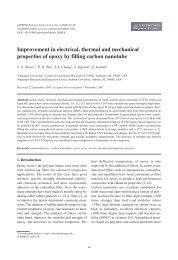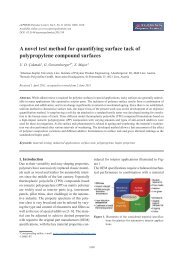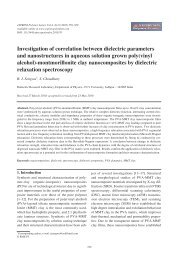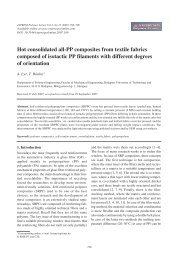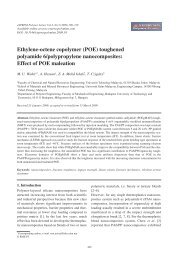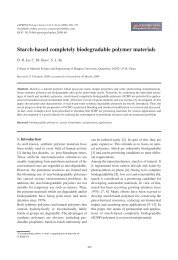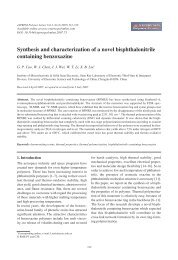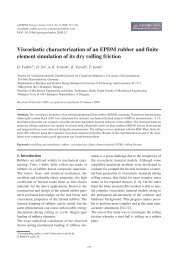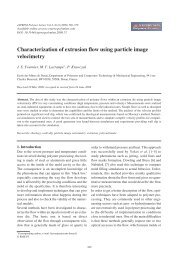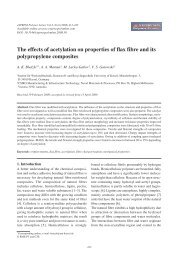Nanotechnology and its applications in lignocellulosic composites, a ...
Nanotechnology and its applications in lignocellulosic composites, a ...
Nanotechnology and its applications in lignocellulosic composites, a ...
You also want an ePaper? Increase the reach of your titles
YUMPU automatically turns print PDFs into web optimized ePapers that Google loves.
Kamel – eXPRESS Polymer Letters Vol.1, No.9 (2007) 546–575<br />
3.7. Thermomechanical analysis<br />
Thermomechanical measurements are perform<br />
us<strong>in</strong>g a thermomechanical analyzer. This analysis<br />
shows the temperature dependencies of a dynamic<br />
storage modulus [92].<br />
3.8. Rheological behavior of suspensions<br />
Rheological data could be collected with a rotat<strong>in</strong>g<br />
rheometer.<br />
4. Applications<br />
4.1. Cellulose–cellulose nano<strong>composites</strong><br />
Composite materials, typically glass fibers or carbon<br />
fibers embedded <strong>in</strong>to epoxy res<strong>in</strong> or unsaturated<br />
polyester, show excellent mechanical <strong>and</strong><br />
thermal properties; thus, they are widely used <strong>in</strong><br />
various <strong>applications</strong> rang<strong>in</strong>g from aerospace to<br />
vehicles to sports utensils [109]. However, these<br />
advantages cause environmental problems when<br />
dispos<strong>in</strong>g by <strong>in</strong>c<strong>in</strong>eration. Consequently, there are<br />
grow<strong>in</strong>g dem<strong>and</strong>s for environmentally friendly<br />
<strong>composites</strong>. Cellulose is the most abundant biomass<br />
resource <strong>and</strong> possesses excellent mechanical<br />
<strong>and</strong> thermal properties as mention before. Natural<br />
cellulose (cellulose I) also boasts an elastic modulus,<br />
E l , of 138 GPa for the crystall<strong>in</strong>e regions <strong>in</strong> the<br />
direction parallel to the cha<strong>in</strong> axis. This is comparable<br />
with the E l values of high performance synthetic<br />
fibers such as poly (phenylene terephthalamide)<br />
130 GPa. In addition, the maximum macroscopic<br />
Young’s modulus of natural plant cellulose (up to<br />
128 GPa) is higher than those of alum<strong>in</strong>um<br />
(70 GPa) <strong>and</strong> glass fibers (76 GPa). The ultimate<br />
tensile strength of cellulose is estimated to be<br />
17.8 GPa. This is 7 times higher than that of steel.<br />
Intr<strong>in</strong>sically, the very high elastic modulus <strong>and</strong> tensile<br />
strength (not specific modulus <strong>and</strong> specific<br />
strength) imply that cellulose possesses the potential<br />
to replace glass fiber, <strong>and</strong> it shows promise as a<br />
re<strong>in</strong>forcement fiber for <strong>composites</strong> where the density<br />
is not a concern. Current trends toward environmentally<br />
friendly <strong>composites</strong> focus on the use<br />
of cellulose fibers [110]. The <strong>in</strong>terface between the<br />
fiber <strong>and</strong> the matrix often br<strong>in</strong>gs serious problems<br />
such as poor adhesion <strong>and</strong> water uptake by the<br />
<strong>composites</strong>. On the other h<strong>and</strong>, when the fiber <strong>and</strong><br />
the matrix are composed of the same material,<br />
some benef<strong>its</strong> relevant to recyclability, <strong>and</strong> a better<br />
adhesion at <strong>in</strong>terface, can be expected [111].<br />
Cellulose is well known not to melt, but shows<br />
thermal degradation at high temperature. Therefore,<br />
to process cellulose, a wet process should be<br />
employed. Consequently, cellulose/cellulose composite<br />
was manufactured by the wet process us<strong>in</strong>g<br />
LiCl/N,N-dimethyl acetamide as cellulose solvent<br />
<strong>and</strong> by controll<strong>in</strong>g the solubility of cellulose<br />
through pretreatment conditions. This composite is<br />
totally composed of susta<strong>in</strong>able cellulosic<br />
resources, so it can be biodegradable after service.<br />
Cellulose self-re<strong>in</strong>forced composite, possessed<br />
excellent mechanical <strong>and</strong> thermal properties dur<strong>in</strong>g<br />
use as well as transparent to visible light. This composite<br />
can be used as an alternative of the glassfiber-re<strong>in</strong>forced<br />
composite. By choos<strong>in</strong>g the pretreatment<br />
condition to the fiber, the transverse<br />
mechanical properties of the composite can be also<br />
enhanced through the molecular diffusion across<br />
the <strong>in</strong>terface between the fiber <strong>and</strong> the matrix [92,<br />
111].<br />
The ratio of cellulose I <strong>and</strong> II affects the properties<br />
of the result<strong>in</strong>g nano<strong>composites</strong>. So, cellulosebased<br />
nanocomposite films with different ratios of<br />
cellulose I <strong>and</strong> II were produced by partial dissolution<br />
of microcrystall<strong>in</strong>e cellulose powder <strong>in</strong><br />
LiCl/N,N-dimethyl acetamide <strong>and</strong> subsequent film<br />
cast<strong>in</strong>g. The films are isotropic, transparent to visible<br />
light, highly crystall<strong>in</strong>e, <strong>and</strong> conta<strong>in</strong> different<br />
amounts of un-dissolved cellulose I crystallites as a<br />
filler. By vary<strong>in</strong>g the cellulose I <strong>and</strong> II ratio, the<br />
mechanical performance of the nano<strong>composites</strong><br />
can be tuned depend<strong>in</strong>g on the composition. Also,<br />
the nano<strong>composites</strong> clearly surpass the mechanical<br />
properties of most comparable cellulosic materials,<br />
their greatest advantage be<strong>in</strong>g the fact that they are<br />
fully biobased <strong>and</strong> biodegradable, but also of relatively<br />
high strength [92].<br />
4.2. Nano<strong>composites</strong> from cellulose<br />
derivatives<br />
The chemical modification of dissolv<strong>in</strong>g-grade<br />
wood pulp fibers with a variety of acids <strong>and</strong> anhydrides<br />
represents longst<strong>and</strong><strong>in</strong>g <strong>in</strong>dustrial practice.<br />
Cellulose ethers <strong>and</strong> cellulose esters are used for a<br />
wide variety of products <strong>in</strong> the food, household<br />
products, health care, textile, <strong>and</strong> many other <strong>in</strong>dustries.<br />
Esters with short alkyl cha<strong>in</strong>s (acetate or propionate)<br />
form solvent-soluble, sp<strong>in</strong>nable fibers;<br />
559




